Research Proposal: Leadership's Impact on Workforce Productivity
VerifiedAdded on 2023/06/16
|10
|1762
|343
Report
AI Summary
This research proposal explores the impact of leadership on organizational workforce productivity, focusing on Unilever as a case study. The proposal outlines the background, significance, aims, and objectives of the research, including understanding leadership concepts, evaluating Unilever's leadership approaches, and identifying challenges. It details the research methodology, including the use of epistemology with a positivism philosophy, data collection through questionnaires and literature reviews, and probability sampling with 40 respondents. The proposal anticipates potential difficulties such as accessing confidential information and ethical concerns, and suggests strategies for addressing these issues, such as obtaining informed consent and ensuring privacy. The research aims to analyze effective leadership approaches and their role in enhancing employee productivity, providing valuable insights for both professional skill development and improved communication.
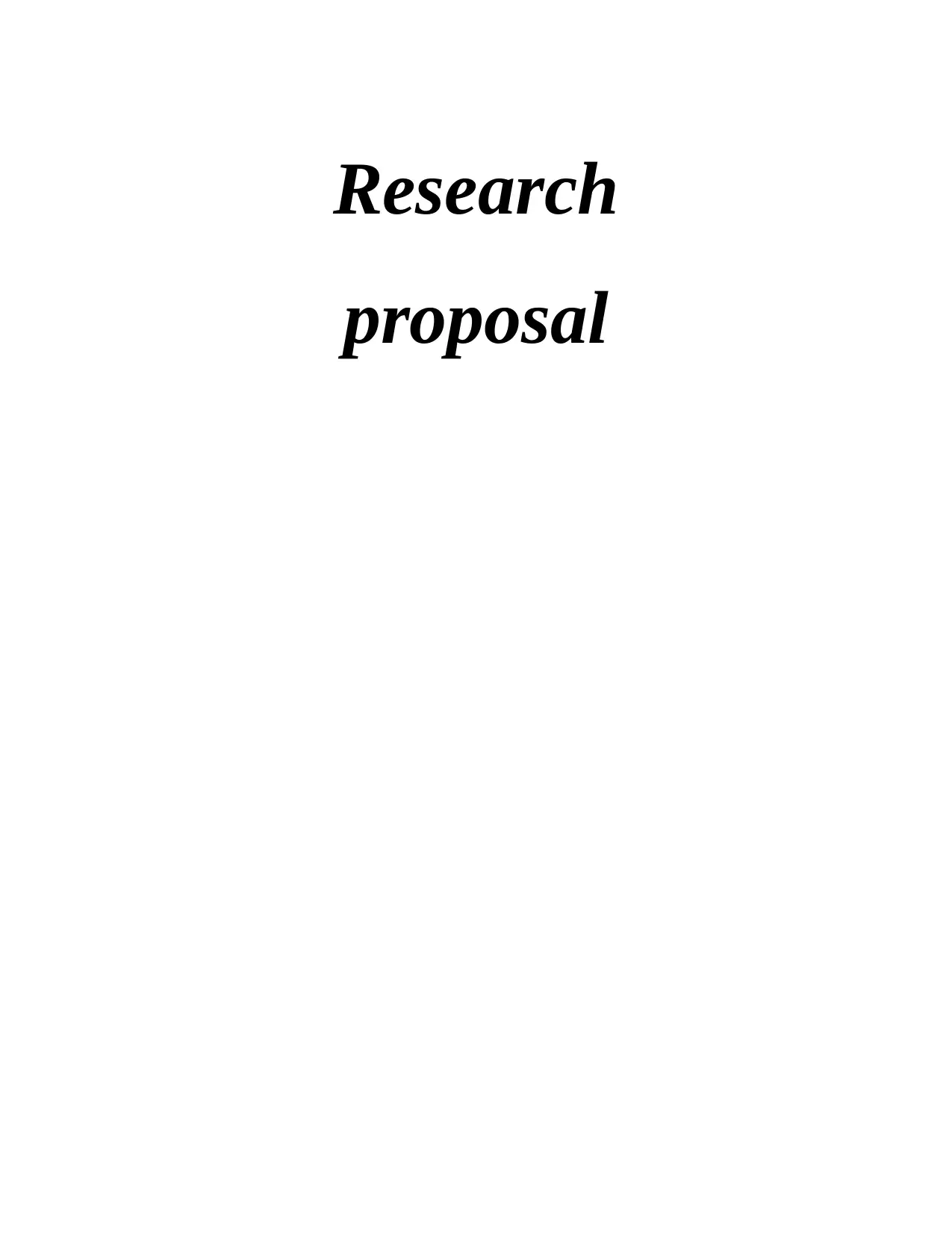
Research
proposal
proposal
Paraphrase This Document
Need a fresh take? Get an instant paraphrase of this document with our AI Paraphraser
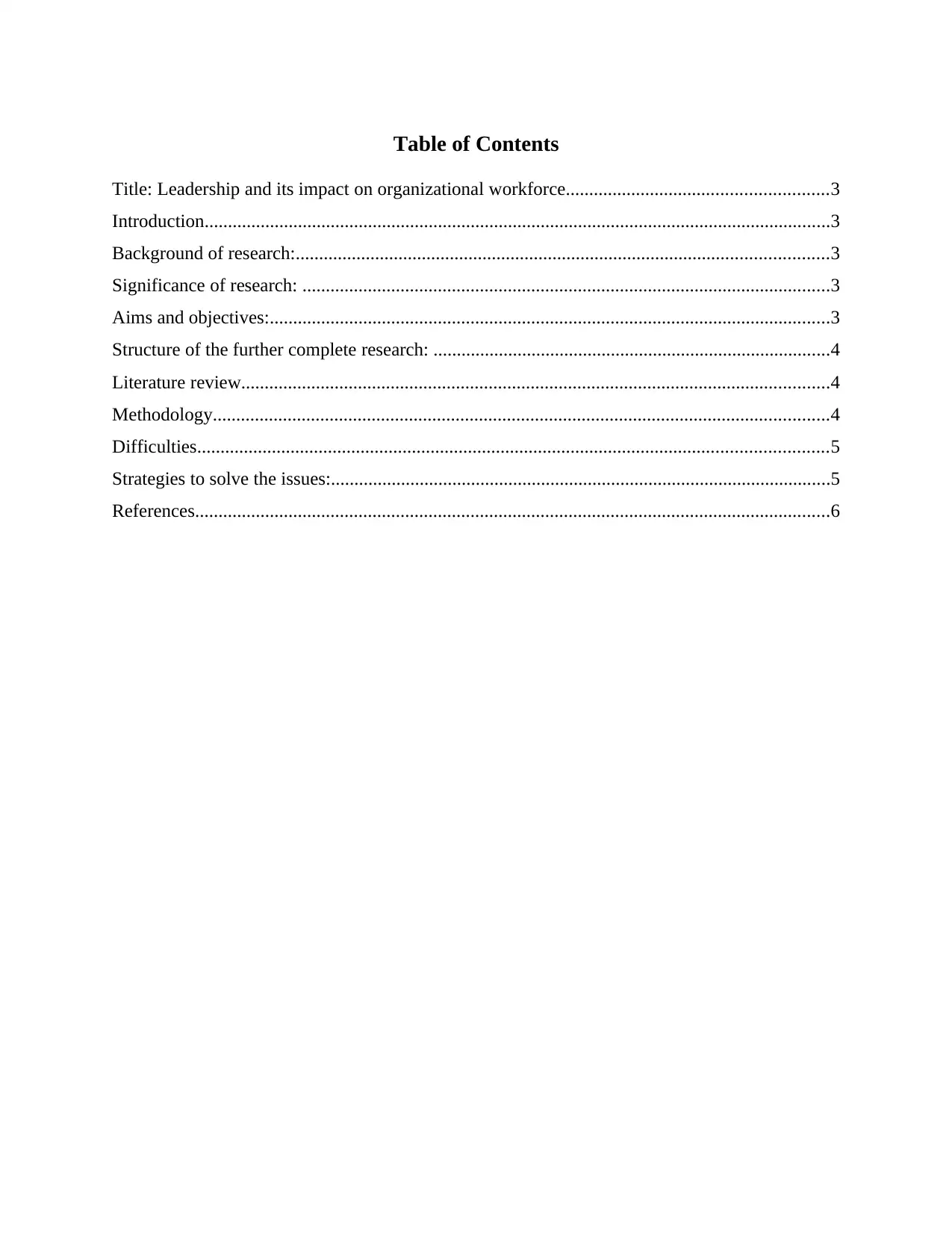
Table of Contents
Title: Leadership and its impact on organizational workforce........................................................3
Introduction......................................................................................................................................3
Background of research:..................................................................................................................3
Significance of research: .................................................................................................................3
Aims and objectives:........................................................................................................................3
Structure of the further complete research: .....................................................................................4
Literature review..............................................................................................................................4
Methodology....................................................................................................................................4
Difficulties.......................................................................................................................................5
Strategies to solve the issues:...........................................................................................................5
References........................................................................................................................................6
Title: Leadership and its impact on organizational workforce........................................................3
Introduction......................................................................................................................................3
Background of research:..................................................................................................................3
Significance of research: .................................................................................................................3
Aims and objectives:........................................................................................................................3
Structure of the further complete research: .....................................................................................4
Literature review..............................................................................................................................4
Methodology....................................................................................................................................4
Difficulties.......................................................................................................................................5
Strategies to solve the issues:...........................................................................................................5
References........................................................................................................................................6
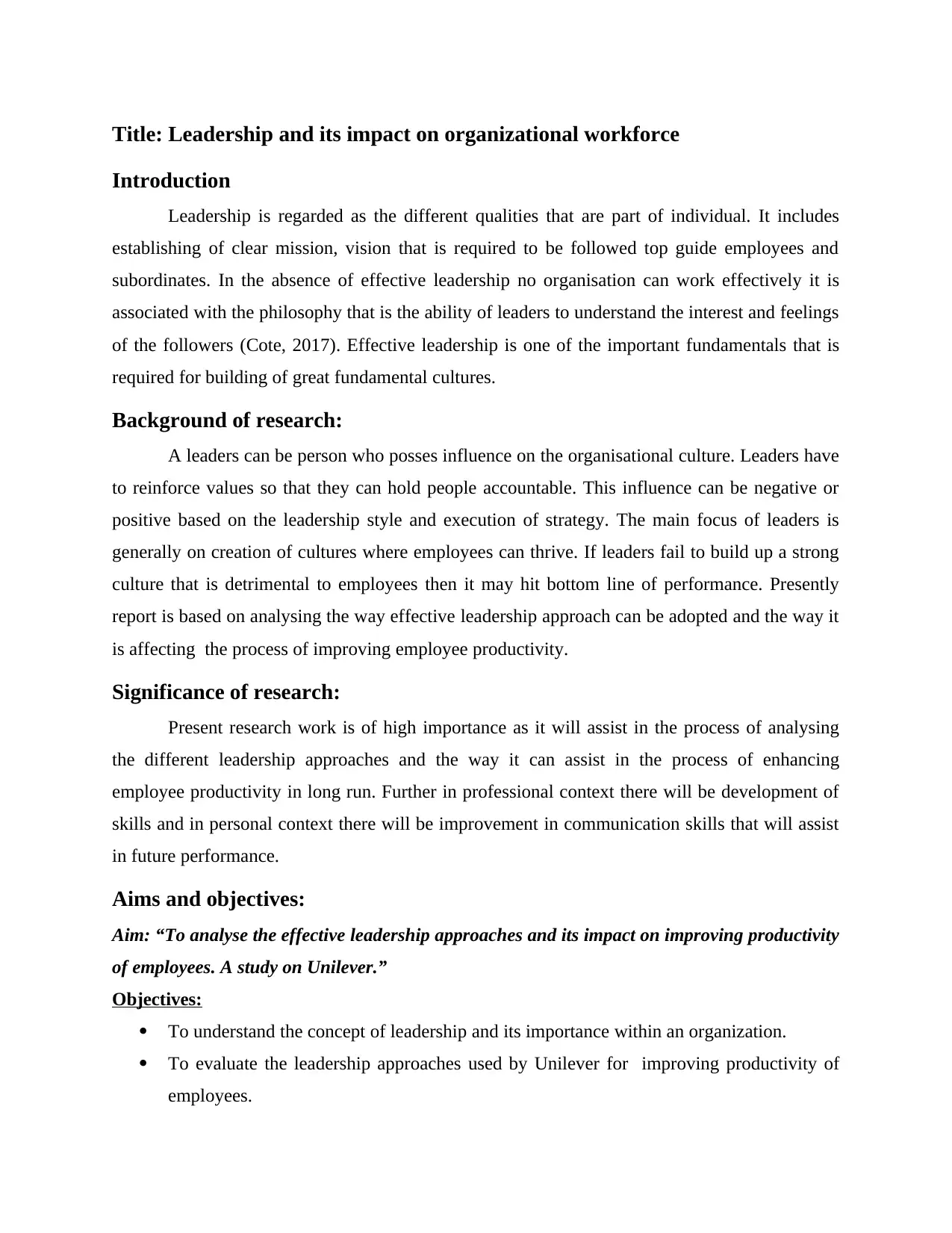
Title: Leadership and its impact on organizational workforce
Introduction
Leadership is regarded as the different qualities that are part of individual. It includes
establishing of clear mission, vision that is required to be followed top guide employees and
subordinates. In the absence of effective leadership no organisation can work effectively it is
associated with the philosophy that is the ability of leaders to understand the interest and feelings
of the followers (Cote, 2017). Effective leadership is one of the important fundamentals that is
required for building of great fundamental cultures.
Background of research:
A leaders can be person who posses influence on the organisational culture. Leaders have
to reinforce values so that they can hold people accountable. This influence can be negative or
positive based on the leadership style and execution of strategy. The main focus of leaders is
generally on creation of cultures where employees can thrive. If leaders fail to build up a strong
culture that is detrimental to employees then it may hit bottom line of performance. Presently
report is based on analysing the way effective leadership approach can be adopted and the way it
is affecting the process of improving employee productivity.
Significance of research:
Present research work is of high importance as it will assist in the process of analysing
the different leadership approaches and the way it can assist in the process of enhancing
employee productivity in long run. Further in professional context there will be development of
skills and in personal context there will be improvement in communication skills that will assist
in future performance.
Aims and objectives:
Aim: “To analyse the effective leadership approaches and its impact on improving productivity
of employees. A study on Unilever.”
Objectives:
To understand the concept of leadership and its importance within an organization.
To evaluate the leadership approaches used by Unilever for improving productivity of
employees.
Introduction
Leadership is regarded as the different qualities that are part of individual. It includes
establishing of clear mission, vision that is required to be followed top guide employees and
subordinates. In the absence of effective leadership no organisation can work effectively it is
associated with the philosophy that is the ability of leaders to understand the interest and feelings
of the followers (Cote, 2017). Effective leadership is one of the important fundamentals that is
required for building of great fundamental cultures.
Background of research:
A leaders can be person who posses influence on the organisational culture. Leaders have
to reinforce values so that they can hold people accountable. This influence can be negative or
positive based on the leadership style and execution of strategy. The main focus of leaders is
generally on creation of cultures where employees can thrive. If leaders fail to build up a strong
culture that is detrimental to employees then it may hit bottom line of performance. Presently
report is based on analysing the way effective leadership approach can be adopted and the way it
is affecting the process of improving employee productivity.
Significance of research:
Present research work is of high importance as it will assist in the process of analysing
the different leadership approaches and the way it can assist in the process of enhancing
employee productivity in long run. Further in professional context there will be development of
skills and in personal context there will be improvement in communication skills that will assist
in future performance.
Aims and objectives:
Aim: “To analyse the effective leadership approaches and its impact on improving productivity
of employees. A study on Unilever.”
Objectives:
To understand the concept of leadership and its importance within an organization.
To evaluate the leadership approaches used by Unilever for improving productivity of
employees.
⊘ This is a preview!⊘
Do you want full access?
Subscribe today to unlock all pages.

Trusted by 1+ million students worldwide
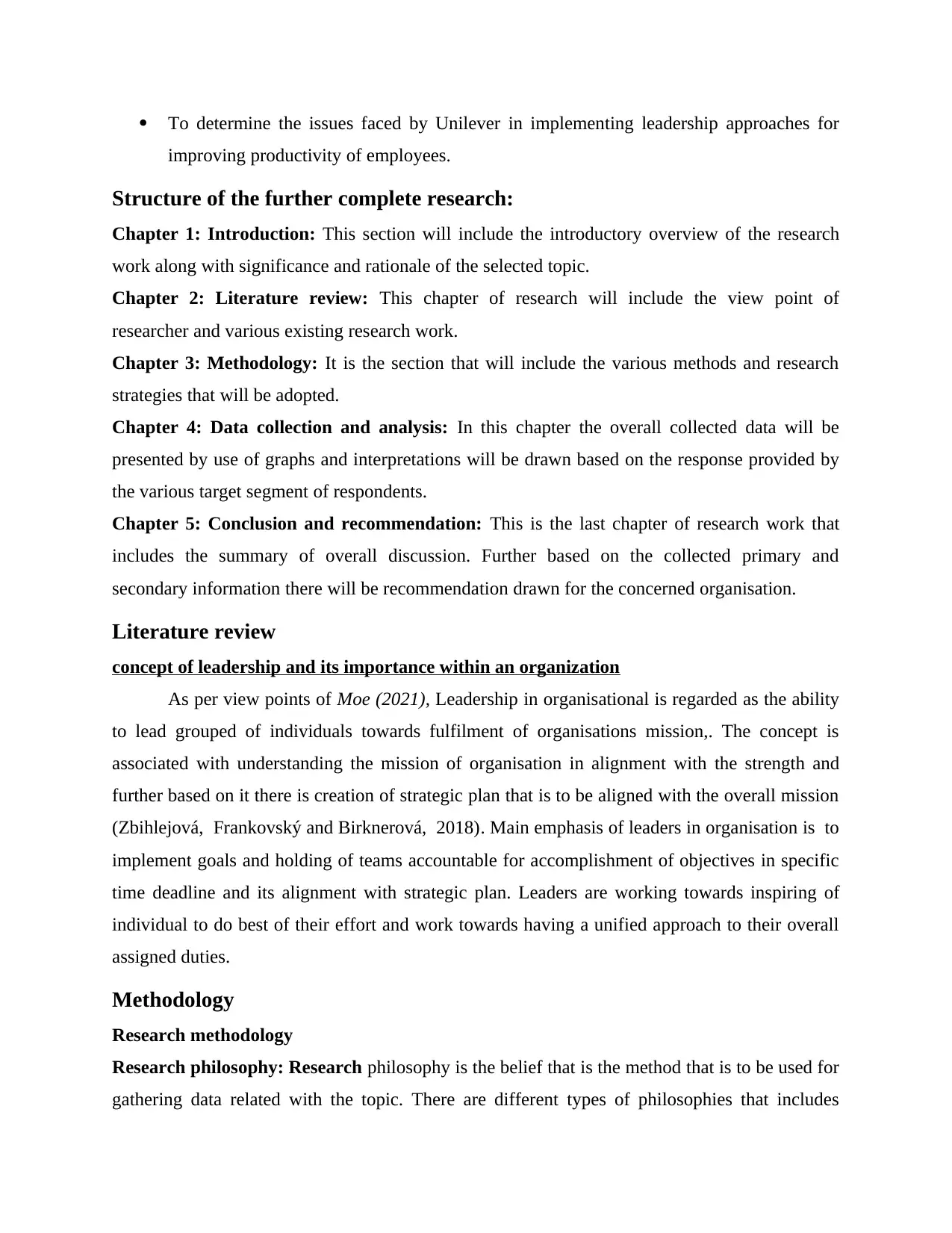
To determine the issues faced by Unilever in implementing leadership approaches for
improving productivity of employees.
Structure of the further complete research:
Chapter 1: Introduction: This section will include the introductory overview of the research
work along with significance and rationale of the selected topic.
Chapter 2: Literature review: This chapter of research will include the view point of
researcher and various existing research work.
Chapter 3: Methodology: It is the section that will include the various methods and research
strategies that will be adopted.
Chapter 4: Data collection and analysis: In this chapter the overall collected data will be
presented by use of graphs and interpretations will be drawn based on the response provided by
the various target segment of respondents.
Chapter 5: Conclusion and recommendation: This is the last chapter of research work that
includes the summary of overall discussion. Further based on the collected primary and
secondary information there will be recommendation drawn for the concerned organisation.
Literature review
concept of leadership and its importance within an organization
As per view points of Moe (2021), Leadership in organisational is regarded as the ability
to lead grouped of individuals towards fulfilment of organisations mission,. The concept is
associated with understanding the mission of organisation in alignment with the strength and
further based on it there is creation of strategic plan that is to be aligned with the overall mission
(Zbihlejová, Frankovský and Birknerová, 2018). Main emphasis of leaders in organisation is to
implement goals and holding of teams accountable for accomplishment of objectives in specific
time deadline and its alignment with strategic plan. Leaders are working towards inspiring of
individual to do best of their effort and work towards having a unified approach to their overall
assigned duties.
Methodology
Research methodology
Research philosophy: Research philosophy is the belief that is the method that is to be used for
gathering data related with the topic. There are different types of philosophies that includes
improving productivity of employees.
Structure of the further complete research:
Chapter 1: Introduction: This section will include the introductory overview of the research
work along with significance and rationale of the selected topic.
Chapter 2: Literature review: This chapter of research will include the view point of
researcher and various existing research work.
Chapter 3: Methodology: It is the section that will include the various methods and research
strategies that will be adopted.
Chapter 4: Data collection and analysis: In this chapter the overall collected data will be
presented by use of graphs and interpretations will be drawn based on the response provided by
the various target segment of respondents.
Chapter 5: Conclusion and recommendation: This is the last chapter of research work that
includes the summary of overall discussion. Further based on the collected primary and
secondary information there will be recommendation drawn for the concerned organisation.
Literature review
concept of leadership and its importance within an organization
As per view points of Moe (2021), Leadership in organisational is regarded as the ability
to lead grouped of individuals towards fulfilment of organisations mission,. The concept is
associated with understanding the mission of organisation in alignment with the strength and
further based on it there is creation of strategic plan that is to be aligned with the overall mission
(Zbihlejová, Frankovský and Birknerová, 2018). Main emphasis of leaders in organisation is to
implement goals and holding of teams accountable for accomplishment of objectives in specific
time deadline and its alignment with strategic plan. Leaders are working towards inspiring of
individual to do best of their effort and work towards having a unified approach to their overall
assigned duties.
Methodology
Research methodology
Research philosophy: Research philosophy is the belief that is the method that is to be used for
gathering data related with the topic. There are different types of philosophies that includes
Paraphrase This Document
Need a fresh take? Get an instant paraphrase of this document with our AI Paraphraser
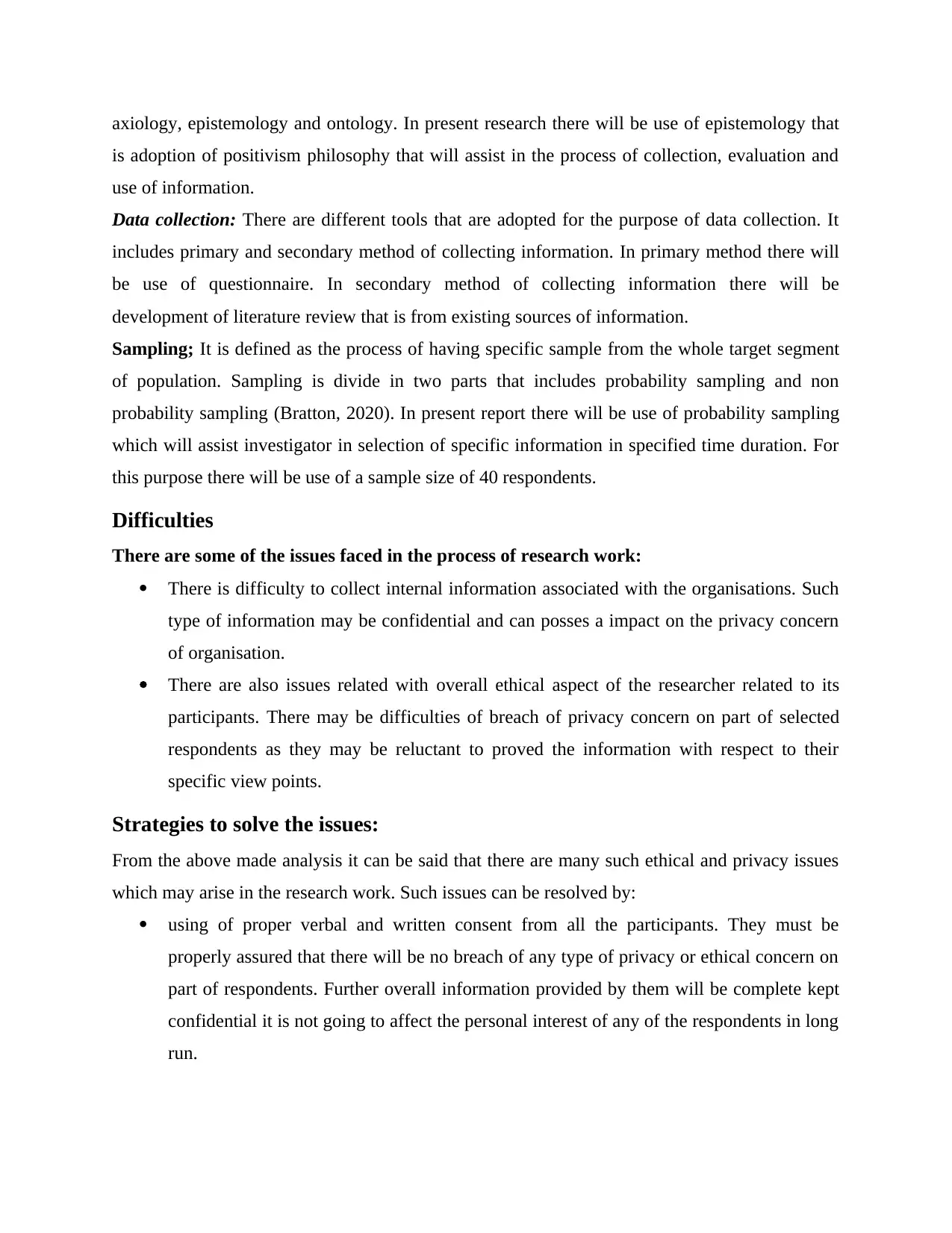
axiology, epistemology and ontology. In present research there will be use of epistemology that
is adoption of positivism philosophy that will assist in the process of collection, evaluation and
use of information.
Data collection: There are different tools that are adopted for the purpose of data collection. It
includes primary and secondary method of collecting information. In primary method there will
be use of questionnaire. In secondary method of collecting information there will be
development of literature review that is from existing sources of information.
Sampling; It is defined as the process of having specific sample from the whole target segment
of population. Sampling is divide in two parts that includes probability sampling and non
probability sampling (Bratton, 2020). In present report there will be use of probability sampling
which will assist investigator in selection of specific information in specified time duration. For
this purpose there will be use of a sample size of 40 respondents.
Difficulties
There are some of the issues faced in the process of research work:
There is difficulty to collect internal information associated with the organisations. Such
type of information may be confidential and can posses a impact on the privacy concern
of organisation.
There are also issues related with overall ethical aspect of the researcher related to its
participants. There may be difficulties of breach of privacy concern on part of selected
respondents as they may be reluctant to proved the information with respect to their
specific view points.
Strategies to solve the issues:
From the above made analysis it can be said that there are many such ethical and privacy issues
which may arise in the research work. Such issues can be resolved by:
using of proper verbal and written consent from all the participants. They must be
properly assured that there will be no breach of any type of privacy or ethical concern on
part of respondents. Further overall information provided by them will be complete kept
confidential it is not going to affect the personal interest of any of the respondents in long
run.
is adoption of positivism philosophy that will assist in the process of collection, evaluation and
use of information.
Data collection: There are different tools that are adopted for the purpose of data collection. It
includes primary and secondary method of collecting information. In primary method there will
be use of questionnaire. In secondary method of collecting information there will be
development of literature review that is from existing sources of information.
Sampling; It is defined as the process of having specific sample from the whole target segment
of population. Sampling is divide in two parts that includes probability sampling and non
probability sampling (Bratton, 2020). In present report there will be use of probability sampling
which will assist investigator in selection of specific information in specified time duration. For
this purpose there will be use of a sample size of 40 respondents.
Difficulties
There are some of the issues faced in the process of research work:
There is difficulty to collect internal information associated with the organisations. Such
type of information may be confidential and can posses a impact on the privacy concern
of organisation.
There are also issues related with overall ethical aspect of the researcher related to its
participants. There may be difficulties of breach of privacy concern on part of selected
respondents as they may be reluctant to proved the information with respect to their
specific view points.
Strategies to solve the issues:
From the above made analysis it can be said that there are many such ethical and privacy issues
which may arise in the research work. Such issues can be resolved by:
using of proper verbal and written consent from all the participants. They must be
properly assured that there will be no breach of any type of privacy or ethical concern on
part of respondents. Further overall information provided by them will be complete kept
confidential it is not going to affect the personal interest of any of the respondents in long
run.
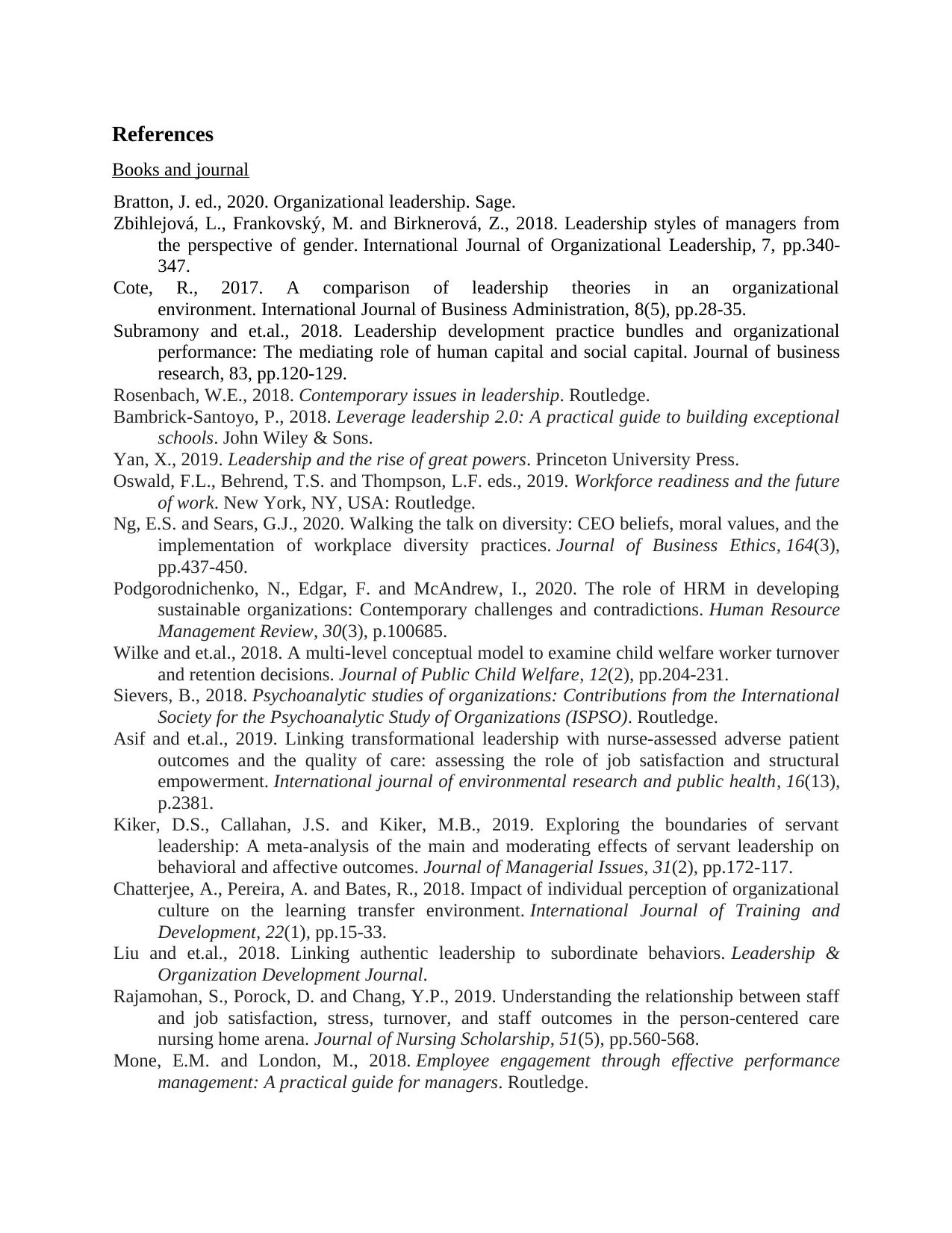
References
Books and journal
Bratton, J. ed., 2020. Organizational leadership. Sage.
Zbihlejová, L., Frankovský, M. and Birknerová, Z., 2018. Leadership styles of managers from
the perspective of gender. International Journal of Organizational Leadership, 7, pp.340-
347.
Cote, R., 2017. A comparison of leadership theories in an organizational
environment. International Journal of Business Administration, 8(5), pp.28-35.
Subramony and et.al., 2018. Leadership development practice bundles and organizational
performance: The mediating role of human capital and social capital. Journal of business
research, 83, pp.120-129.
Rosenbach, W.E., 2018. Contemporary issues in leadership. Routledge.
Bambrick-Santoyo, P., 2018. Leverage leadership 2.0: A practical guide to building exceptional
schools. John Wiley & Sons.
Yan, X., 2019. Leadership and the rise of great powers. Princeton University Press.
Oswald, F.L., Behrend, T.S. and Thompson, L.F. eds., 2019. Workforce readiness and the future
of work. New York, NY, USA: Routledge.
Ng, E.S. and Sears, G.J., 2020. Walking the talk on diversity: CEO beliefs, moral values, and the
implementation of workplace diversity practices. Journal of Business Ethics, 164(3),
pp.437-450.
Podgorodnichenko, N., Edgar, F. and McAndrew, I., 2020. The role of HRM in developing
sustainable organizations: Contemporary challenges and contradictions. Human Resource
Management Review, 30(3), p.100685.
Wilke and et.al., 2018. A multi-level conceptual model to examine child welfare worker turnover
and retention decisions. Journal of Public Child Welfare, 12(2), pp.204-231.
Sievers, B., 2018. Psychoanalytic studies of organizations: Contributions from the International
Society for the Psychoanalytic Study of Organizations (ISPSO). Routledge.
Asif and et.al., 2019. Linking transformational leadership with nurse-assessed adverse patient
outcomes and the quality of care: assessing the role of job satisfaction and structural
empowerment. International journal of environmental research and public health, 16(13),
p.2381.
Kiker, D.S., Callahan, J.S. and Kiker, M.B., 2019. Exploring the boundaries of servant
leadership: A meta-analysis of the main and moderating effects of servant leadership on
behavioral and affective outcomes. Journal of Managerial Issues, 31(2), pp.172-117.
Chatterjee, A., Pereira, A. and Bates, R., 2018. Impact of individual perception of organizational
culture on the learning transfer environment. International Journal of Training and
Development, 22(1), pp.15-33.
Liu and et.al., 2018. Linking authentic leadership to subordinate behaviors. Leadership &
Organization Development Journal.
Rajamohan, S., Porock, D. and Chang, Y.P., 2019. Understanding the relationship between staff
and job satisfaction, stress, turnover, and staff outcomes in the person‐centered care
nursing home arena. Journal of Nursing Scholarship, 51(5), pp.560-568.
Mone, E.M. and London, M., 2018. Employee engagement through effective performance
management: A practical guide for managers. Routledge.
Books and journal
Bratton, J. ed., 2020. Organizational leadership. Sage.
Zbihlejová, L., Frankovský, M. and Birknerová, Z., 2018. Leadership styles of managers from
the perspective of gender. International Journal of Organizational Leadership, 7, pp.340-
347.
Cote, R., 2017. A comparison of leadership theories in an organizational
environment. International Journal of Business Administration, 8(5), pp.28-35.
Subramony and et.al., 2018. Leadership development practice bundles and organizational
performance: The mediating role of human capital and social capital. Journal of business
research, 83, pp.120-129.
Rosenbach, W.E., 2018. Contemporary issues in leadership. Routledge.
Bambrick-Santoyo, P., 2018. Leverage leadership 2.0: A practical guide to building exceptional
schools. John Wiley & Sons.
Yan, X., 2019. Leadership and the rise of great powers. Princeton University Press.
Oswald, F.L., Behrend, T.S. and Thompson, L.F. eds., 2019. Workforce readiness and the future
of work. New York, NY, USA: Routledge.
Ng, E.S. and Sears, G.J., 2020. Walking the talk on diversity: CEO beliefs, moral values, and the
implementation of workplace diversity practices. Journal of Business Ethics, 164(3),
pp.437-450.
Podgorodnichenko, N., Edgar, F. and McAndrew, I., 2020. The role of HRM in developing
sustainable organizations: Contemporary challenges and contradictions. Human Resource
Management Review, 30(3), p.100685.
Wilke and et.al., 2018. A multi-level conceptual model to examine child welfare worker turnover
and retention decisions. Journal of Public Child Welfare, 12(2), pp.204-231.
Sievers, B., 2018. Psychoanalytic studies of organizations: Contributions from the International
Society for the Psychoanalytic Study of Organizations (ISPSO). Routledge.
Asif and et.al., 2019. Linking transformational leadership with nurse-assessed adverse patient
outcomes and the quality of care: assessing the role of job satisfaction and structural
empowerment. International journal of environmental research and public health, 16(13),
p.2381.
Kiker, D.S., Callahan, J.S. and Kiker, M.B., 2019. Exploring the boundaries of servant
leadership: A meta-analysis of the main and moderating effects of servant leadership on
behavioral and affective outcomes. Journal of Managerial Issues, 31(2), pp.172-117.
Chatterjee, A., Pereira, A. and Bates, R., 2018. Impact of individual perception of organizational
culture on the learning transfer environment. International Journal of Training and
Development, 22(1), pp.15-33.
Liu and et.al., 2018. Linking authentic leadership to subordinate behaviors. Leadership &
Organization Development Journal.
Rajamohan, S., Porock, D. and Chang, Y.P., 2019. Understanding the relationship between staff
and job satisfaction, stress, turnover, and staff outcomes in the person‐centered care
nursing home arena. Journal of Nursing Scholarship, 51(5), pp.560-568.
Mone, E.M. and London, M., 2018. Employee engagement through effective performance
management: A practical guide for managers. Routledge.
⊘ This is a preview!⊘
Do you want full access?
Subscribe today to unlock all pages.

Trusted by 1+ million students worldwide
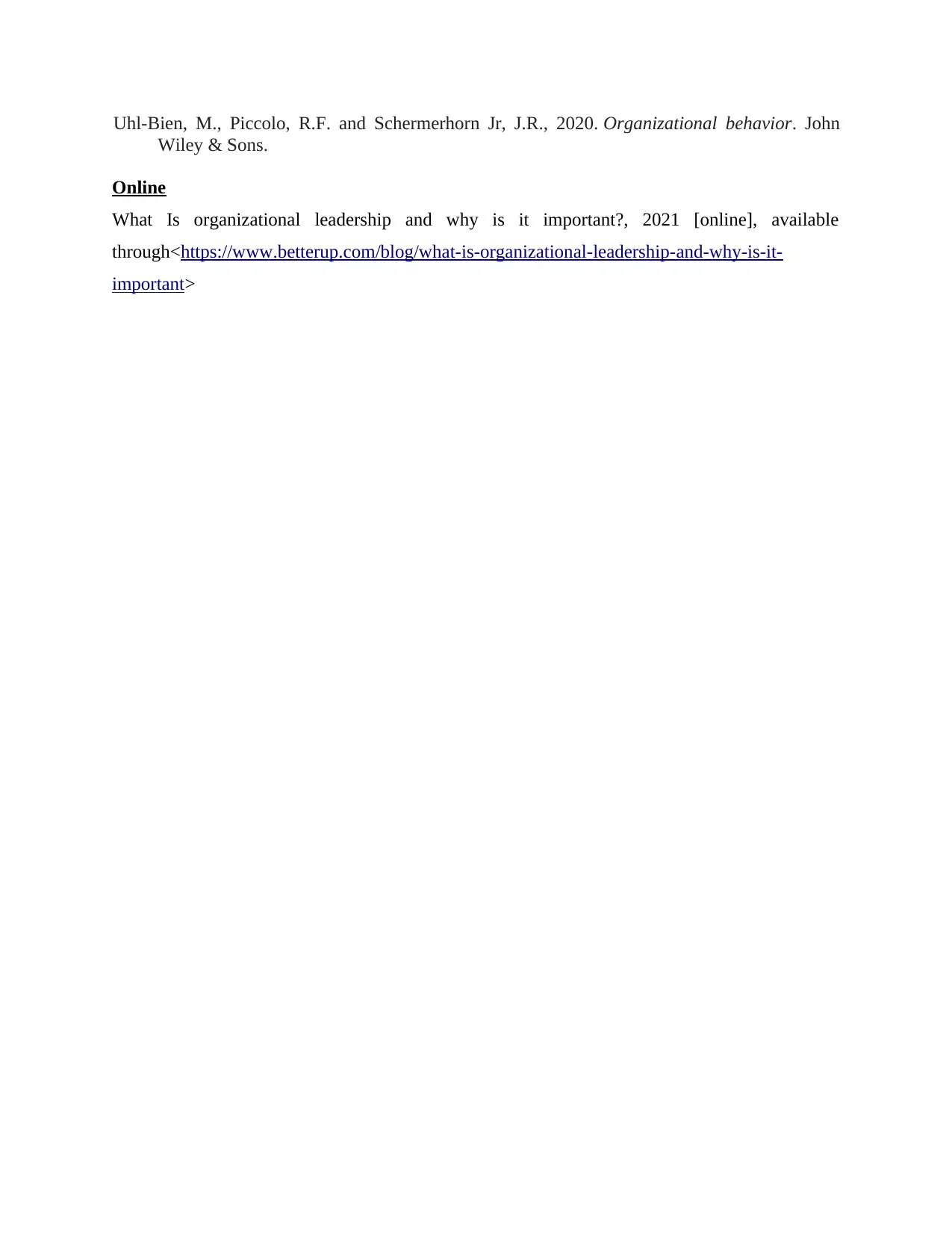
Uhl-Bien, M., Piccolo, R.F. and Schermerhorn Jr, J.R., 2020. Organizational behavior. John
Wiley & Sons.
Online
What Is organizational leadership and why is it important?, 2021 [online], available
through<https://www.betterup.com/blog/what-is-organizational-leadership-and-why-is-it-
important>
Wiley & Sons.
Online
What Is organizational leadership and why is it important?, 2021 [online], available
through<https://www.betterup.com/blog/what-is-organizational-leadership-and-why-is-it-
important>
Paraphrase This Document
Need a fresh take? Get an instant paraphrase of this document with our AI Paraphraser


⊘ This is a preview!⊘
Do you want full access?
Subscribe today to unlock all pages.

Trusted by 1+ million students worldwide

1 out of 10
Related Documents
Your All-in-One AI-Powered Toolkit for Academic Success.
+13062052269
info@desklib.com
Available 24*7 on WhatsApp / Email
![[object Object]](/_next/static/media/star-bottom.7253800d.svg)
Unlock your academic potential
Copyright © 2020–2025 A2Z Services. All Rights Reserved. Developed and managed by ZUCOL.




